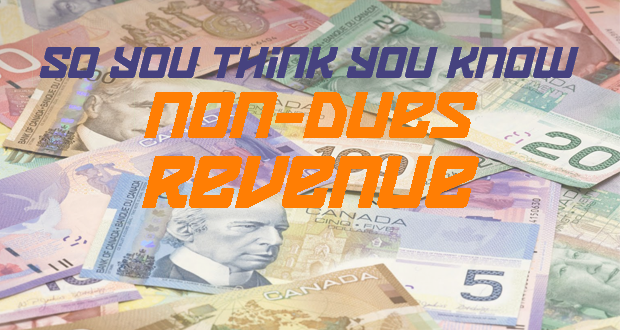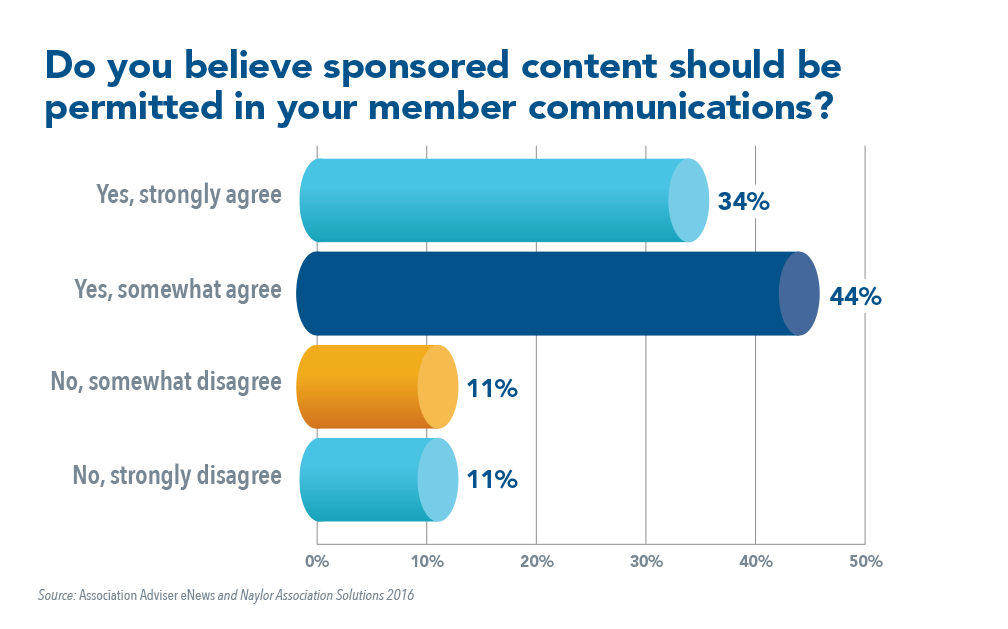So You Think You Know Non-Dues Revenue


Is your model evolving as fast as the world around you?
Economic indicators show a U.S. economy that’s in better shape than at any time since the Great Recession of 2008-09. But, that prosperity isn’t necessarily trickling down to the association world. More than half (54 percent) of the executives who took part in our annual association communication benchmarking study felt their organization’s inability to generate non-dues-revenue (NDR) was a serious or significant challenge — up substantially from 2015.
Percent of Associations agreeing that NDR is a serious challenge:
| 2016 | *********************** 54% |
| 2015 | ***** 11% |
Source: Association Adviser 2015-2016

This disconnect may be related to a lack of measurement or the inability to record reader engagement, according to my colleague Jill Andreu, VP Content Strategy and Development for Naylor Association Solutions ,who will be hosting a webinar about our findings later this month. Less than one-third of respondents to our study reported having a process in place for measuring member engagement with their communications. Nearly half (48 percent) said they consider their ability to measure communication effectiveness a serious or significant problem, said Andreu. “A lack of confidence in the ability to show sponsors or advertisers a return on their investment can hinder an association’s enthusiasm to pursue non-dues revenue opportunities,” Andreu added.
![]()
[ctt_hbox link=”X6O67″ ]The competitive field is larger than ever for associations: http://ctt.ec/X6O67+ @AssocAdviser[/ctt_hbox]
[ctt_hbox link=”5y3CW” ]NDR is an initiative that needs to be owned. It’s no longer a side project that teams do when they have time: http://ctt.ec/5y3CW+ @AssocAdviser[/ctt_hbox]
[ctt_hbox link=”V4gf3″ ]Don’t be defensive about the value of your assets and audience. Cost-plus pricing doesn’t cut it anymore: http://ctt.ec/V4gf3+ @AssocAdviser[/ctt_hbox]

Carla Kalogeridis, editorial director and publisher, Association Media & Publishing said associations often get “bogged down” in day-to-day operations and servicing member needs. “They don’t always carve out enough time to think and act strategically. NDR opportunities are definitely there, but someone needs to “own the NDR initiative” instead of having various departments “take a stab” at it when they have time,” added Kalogeridis.
Addressing the NDR challenge

Bob Weidner, president and CEO of the Metals Service Center Institute (MSCI), said there’s no such thing as the status quo anymore. “Treading water and just trying to survive is a recipe for disaster. If you don’t keep growing, you’ll just wither away and die—or the market will take you out.” Weidner said MSCI tries to come up with products and services that represent real value to members — and which help grow the top line. “Yes, we’re trade associations, but we’re also running businesses — you HAVE to grow!”

Ian Santo Domingo, principal and managing director of research firm Vault Consulting, LLC, said industry consolidation is shrinking the membership base for many associations. “Finding new and innovative ways to replace these dollars is becoming a priority, rather than a side project for many associations.”
[ctt_hbox link=”5y3CW” ]NDR is an initiative that needs to be owned. It’s no longer a side project that teams do when they have time: http://ctt.ec/5y3CW+ @AssocAdviser[/ctt_hbox]

From an ad sales standpoint, Brittany Shoul, VP sales for Network Media Partners said associations are at a disadvantage because “they cannot deliver (or are unwilling to pay for) the kinds of performance/ROI data that advertisers and media buyers are looking for to justify their spend.” That needs to change fast, she added.
Fastest growing NDR channels

Events, e-mail marketing and custom content provide the fastest growing opportunities for associations, according to Tom Greve, business development director at EMS World and former director of sales and business development at the American Institute of CPAs and The March of Dimes. Kalogeridis agreed. “Meetings are going strong. But, vendors and service providers are looking for unique opportunities and associations that offer custom-designed ideas are getting the business.” On the publications side, Kalogeridis said members want their association not only to aggregate, but analyze information and trends. “Creative packaging of that analysis and effective, multi-channel delivery of that [insight] is attractive to sponsors,” she added.
Executive education is another hot growth area. Weidner said Strategic Metals Management (SMS) has “really moved the needle” for MSCI. He said SMS is a proprietary senior leadership program for up and coming metal industry execs that MSCI puts together in collaboration with Washington University’s Olin Business School in St. Louis. It’s an 18 to 22-month program (costing about $37,000 per attendee) that provides emerging leaders with access to top business professors, real-world education, critical thinking and in-depth professional networking opportunities. “We’ve had about 300 executives go through SMS and it has generated close to $10 million for us since its inception,” added Weidner.
Legacy communication channels still have a seat at the table
When it comes to print magazines, directories, newsletters and live events Kalogeridis observed that she “wouldn’t label them legacy”. “They are at the core of demonstrating member value and communicating the association’s messaging. Digital publications are exciting if done really well and incorporate audio, video, polls, gaming, etc.” but since robust digital can now cost more to produce than paper-based media, “print is enjoying a resurgence,” Kalogeridis noted. She believes that associations really need a combination of both traditional and legacy media. “Digital delivers analytics and real-time response. Print delivers something tangible that is easy and pleasant to absorb. It sits on the member’s desk and reminds them constantly that they are a member of something important,” she added.
Shoul said it’s important to get member feedback about the information, tools and resources they need from your association and to communicate that story to advertisers. “For some of our association clients, the print magazine continues to be their most important and highly rated member benefit. That is the story that advertisers need to hear.”
According to Andreu, Naylor’s annual association communication benchmarking study confirms that an overwhelming 90 percent of survey participants consider conferences and other events “very” or “extremely” valuable. The research also found member eNewsletters and print magazines to be among the most highly rated communication channels (73 and 59 percent, respectively). “Even with new forms of communication popping up yearly, traditional channels are still desired,” added Andreu.

When it comes to live events, no other association may be able to match the social schedule kept by the Asian American Hotel Owners Association. AAHOA’s President & CEO Chip Rogers said his organization hosts 170 events a year. “We never stop providing members with opportunities to meet other hotel owners and vendors so they can find out ‘what’s the latest?’ or ‘what other opportunities are out there for investment, selling or financing?” When you come to one of our events, it’s going to lead to one of three things: making money, saving money or protecting your investment.”
See our Corner Office profile for more insights from Rogers.
Should sponsored content be permitted in your member communications?
More than three-fourths of respondents (78 percent) to a recent unscientific poll of Association Adviser readers agreed that sponsored content is OK within their member communications.

Source: Association Adviser eNews and Naylor Association Solutions 2016
That’s not surprising to EMS World’s Greve. “Readers want to know that the author has “walked the walk.” Sponsored content generated by practitioners and experienced executives provide insight that resonates. Compilations of related articles are being published as e-books to stimulate lead generation and to provide valuable education and training. If content can be approved for CE credit, all the better,” added Greve. The above findings do not surprise Vault’s Santo Domingo either. “Seeing the word ‘sponsor’ doesn’t necessarily mean ‘sales pitch’ if done correctly. Many sponsors have a lot of valuable expertise to share with members, and if it is something that is deemed helpful, I see nothing wrong with it especially if it brings in revenue.” Kalogeridis said the only associations that can afford to turn their backs on sponsored content are the ones that dominate their industries and don’t need the revenue. “Most associations don’t fall into that bucket anymore,” she added.
Christopher Williston VI, SVP of the Independent Bankers Association of Texas said associations should position themselves as trusted arbiters of information for their members and the industries. “Why don’t we harness partnerships with other [providers of expertise] and let the association take the lead by sharing information that can truly benefit members—not the salesy pieces?”
MSCI’s Weidner agreed. “We absolutely think there is value in being a repository of intellectual capital. If you’re talking about white papers like the ones we have on our website and digital publications, the operative phrase is ‘white.’ They must be intellectual thought leadership pieces, not sales literature or a commercial for the sponsoring company.” MSCI vets all sponsored content carefully, and if it passes muster, Weidner said MSCI will include it on its website, in its digital publication and also promote its availability to members.
Sponsored content guidelines
“Advertisers and sponsors are pretty savvy now,” noted Kalogeridis. “They know that being salesy is a turn-off to readers. They’ve had a lot of practice with social media, which has taught all of us that when we engage, we should be all about the customer and not trying to push our own message or product.”
Shoul stressed the importance of providing clear guidelines to your advertising partners, using language such as “Advertiser agrees that content should focus on information, findings, or case study in an objective way that both benefits and informs the audience and does not solely focus on the direct promotion of a company or product.” Shoul said you should also send advertisers and agencies examples of sponsored content that’s run with you in the past — WELL BEFORE they develop a campaign for your media.
Greve said all content EMS runs from companies, bloggers and guest authors must be vetted to keep product endorsements to a minimum. In exchange, Greve said they provide authors of sponsored content with bylines and contact information at the end of their articles.
Collaboration between editorial and sales
Shoul said she and Kalogeridis present frequently about this topic. “In our sessions, we strongly suggest that advertising and editorial teams have standing meeting times to discuss upcoming content, new advertisers and opportunities to work together. The only way to maintain harmony is to build an environment with open communication between these teams.” Kalogeridis said it also helps if sales and editorial take turns “walking in each other’s shoes,” even bringing editors along on sales calls.
Can NDR go too far?
MSCI’s Weidner said the challenge isn’t finding the right ratio between dues and NDR. He said you need to make sure that you, your board and your volunteers are carefully aligned about your mission and philosophy. “Are we going to price based on value or just price enough to cover costs? Cost-plus pricing is a fundamentally flawed model. Do you really know what it costs to produce an iPad is? Who cares? I know what I’m willing to pay for an iPad — the value it gives me,” quipped Weidner.
[ctt_hbox link=”V4gf3″ ]Don’t be defensive about the value of your assets and audience. Cost-plus pricing doesn’t cut it anymore: http://ctt.ec/V4gf3+ @AssocAdviser[/ctt_hbox]
Both Greve and Weidner said the term “not for profit” is just a tax status and not a business model. Kalogeridis said today’s members understand that associations need revenue to continue serving their needs and that their needs can’t be met with just membership dues. “Members only get irritated if they feel they are being sold to all the time and not being given something of value in return.
Conclusion
According to Weidner, there’s an “archaic notion” that if a trade association is growing well then there something evil about it. “As associations, we need capital to invest in new products and new services for our members. That new capital has to come from somewhere. There are startup costs for rolling out new products and services here, just as there are startup costs for everyone from manufacturers to Starbucks. If more association thought in an entrepreneurially and embraced capitalism, their boards wouldn’t be wrestling with so many revenue and sustainability issues.”
Hank Berkowitz is the moderator-in-chief of Association Adviser eNews.

